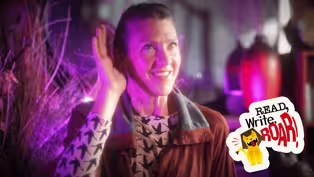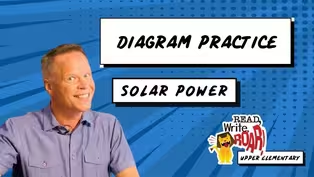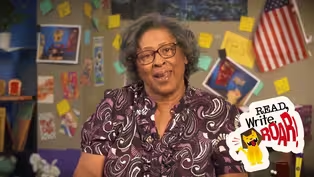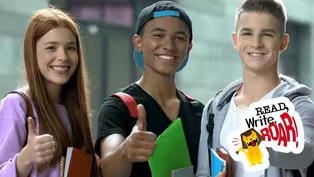Read, Write, ROAR!
Harnessing Our Power - Renewable Energy in Michigan!
Season 1 Episode 1017 | 26m 45sVideo has Closed Captions
Learn how diagrams work as we explore how energy from the sun can power our homes and buildings.
On Read, Write, ROAR! Discover the power of renewable energy. Learn how diagrams work as we explore how energy from the sun can power our homes and buildings. Then, learn about hydropower, power generated by water! Let's go Read, Write, ROAR!
Problems playing video? | Closed Captioning Feedback
Problems playing video? | Closed Captioning Feedback
Read, Write, ROAR! is a local public television program presented by Detroit PBS
Read, Write, ROAR!
Harnessing Our Power - Renewable Energy in Michigan!
Season 1 Episode 1017 | 26m 45sVideo has Closed Captions
On Read, Write, ROAR! Discover the power of renewable energy. Learn how diagrams work as we explore how energy from the sun can power our homes and buildings. Then, learn about hydropower, power generated by water! Let's go Read, Write, ROAR!
Problems playing video? | Closed Captioning Feedback
How to Watch Read, Write, ROAR!
Read, Write, ROAR! is available to stream on pbs.org and the free PBS App, available on iPhone, Apple TV, Android TV, Android smartphones, Amazon Fire TV, Amazon Fire Tablet, Roku, Samsung Smart TV, and Vizio.
Providing Support for PBS.org
Learn Moreabout PBS online sponsorship- On "Read, Write, Roar!"
discover the power of renewable energy.
Learn how diagrams work as we explore how energy from the sun can power our homes and buildings.
Then learn hydropower, or power generated by water.
Let's go read, write, roar.
- [Announcer] This program is made possible in part by the state of Michigan, and by, and by viewers like you.
Thank you.
(energetic rock music) - Do you know what is shocking?
(finger snaps and electricity zaps) How much electrical energy we use in just one day.
Think about it.
From the alarm that wakes you up in the morning to the refrigerator that keeps the milk cold for your breakfast, to the light that shines over your head, we use a lot of electricity.
Hi, it's Mr. Peterson, and we're going to focus not just on how we rely on energy, especially electricity in our lives, but also examine where that electricity comes from.
There are many different sources of electricity, but those sources are typically grouped in two categories, renewable sources and non-renewable sources.
Let's examine both.
Renewable sources are sources that provide us with energy but are naturally renewed or replenish themselves over time.
Two good examples of renewable energy are solar energy and wind energy.
Non-renewable energy has the prefix of "non" which means "not" or not renewable energy.
Examples of non-renewable energy include coal or oil.
We have no way to make coal or oil, so once we have used them up, there won't be any left.
This is why they are non-renewable.
Let's take some time to examine one of the renewable forms of energy, which is being used more and more around the world.
Solar energy or power.
As we learn about solar energy I'm going to make a diagram.
A diagram is a drawing of a structure, system, or process.
We often use diagrams to understand what we are reading.
If you wanna follow along with me while I draw my diagram, all you need is something to draw on and something to write with.
Whatever you have will work fine.
Solar energy starts with the sun.
The suns ray shine down on the Earth and they carry a lot of energy with them.
When you go outside you feel this energy as heat.
If you want to convert solar energy to electricity, you need solar panels, which are also called photovoltaic cells.
Let's break that word down just a little bit.
"Photo" is a prefix you might know.
It means light.
"Ic" is the suffix and it means "of" or "pertaining to."
The root word here is "volt."
A volt is a unit of measurement for electricity.
So photovoltaic means pertaining to light and electricity.
Pretty cool.
Solar panels take the energy from the sun and convert it into direct current electricity.
Because solar panels need light from the sun to generate power, they are typically designed to face the sun.
You'll often see them on the roofs of homes, but sometimes you can find them in large groups out in a field.
This is called a solar farm.
And sometimes you can find small ones on street lights or maybe even on a calculator like the one I have right here.
In my diagram I'm going to draw a house.
And on the roof I'm going to draw some solar panels.
Then I'm going to draw some rays from the sun shining down onto the solar panels.
When solar panels are on the roof of the house, that usually means they are generating power for the people who live there.
So the solar panels generate direct current electricity and feed that electricity down wires to the control box.
The control box converts the direct current electricity into alternating current electricity.
Alternating current is what we need to power the devices in appliances in our homes.
TVs, refrigerators, video game systems, and all of the electrical devices we plug into our outlets are designed to run on alternating current.
Okay, I'm going to draw a box here inside the house.
And I'm going to draw some wires coming from the solar panels down to the control box.
Next, the control box feeds the electricity to a breaker box.
The breaker box contains breakers, which are a safety device used to stop the flow of electricity when there's a problem.
The breaker box contains many different breakers, and each is connected to wires in different parts of the house that end in an outlet.
So I'm going to draw a box right next to our control box, and then I'm going to draw some wires going from the control box to the breaker box, and then from the breaker box to the outlets.
When an appliance or an electrical device is plugged into the outlet, the power flows from the outlet into the device powering it.
Let's take a look at our full diagram.
Photovoltaic cells convert the sun's rays to direct current electricity.
The electricity flows down wires to the control box.
The control box converts direct current electricity to alternating current electricity.
The alternating current flows to the breaker box where it then flows through the breakers and to the outlets all over the house.
When a device is plugged in the power flows through the outlet and into the device, powering it.
Now that we created this diagram, we can use it as an organizer to do a writing about how solar power works.
The next time you're writing about a complicated process, try making a diagram.
What an electrifying lesson (finger snaps and electricity zaps) to help us with our writing.
(energetic rock music) (upbeat music) - I'm Ms. AP here to help restore your energy.
But before we begin, let's start our warmup.
Today we're gonna do five jumping jacks.
Ready, set, go.
One, two, three, four, five.
Nice job.
Now that we've warmed up our bodies, we are ready to exercise.
Today we are gonna work on squats.
The squat movement looks a lot like sitting down and standing up from a chair.
Today I would like you to stand in your ready position with your feet apart, hands at your side.
Now we are going to bend our knees to lower our bodies like we are getting ready to sit down in a pretend chair.
Once you are sitting in your pretend chair and hold it there, and then stand back up straight by pushing tall through your heels to stand back up.
Let's try it together.
Standing in your ready position.
Sit down in your imaginary chair.
Stand back up straight, tall.
Try it one more time.
Standing back up straight, tall.
Now let's see how many we can do.
(energetic music) Give yourselves a big clap-clap.
(hands clapping) Nice job.
Let's start our cool down.
Take two deep breaths in.
Breathe out.
One.
Breathe in.
Breathe out.
Two.
Great job.
(energetic rock music) - Do you ever find complicated words while you're reading?
I know I do.
I'm Mrs. Mora.
Today we'll learn to use word parts like prefixes and suffixes to read and understand unknown words.
Recently I've been reading about different energy sources and I've come across some difficult words.
Here's a word.
First, let's circle the prefixes.
A prefix is a word part added to the beginning of a word to change its meaning.
Do you see a prefix?
It's R-E, "re."
Now let's circle the suffixes.
A suffix is a word part added to the end of word to change its meaning.
Do you see a suffix?
Here's the suffix.
A-B-L-E.
It looks like the word "able," but we pronounce the A with the schwa sound because that syllable is unstressed.
Uh.
Uhble.
Next, let's mark the vowels in the root, or base word.
Vowels help us break words into syllables.
Each syllable can have only one vowel sound.
Which vowels do you see?
We see the letters E-W, which often work as a team to make the vowel sound "ooh."
Since there is one vowel sound, we expect to find one syllable in this middle part.
Let's say the word parts.
Re.
New.
Able.
Now, let's say the whole word.
Renewable.
Is that a real word?
It is.
Since this is a real word, we're finished.
We can add prefixes and suffixes to base words like "new" To make related words.
Let's add the prefix, R-E to the base word "new."
Read with me.
Re.
New.
Renew.
Renew is a verb or an action word that sometimes means to make something like new again.
Now let's add the A-B-L-E suffix to the word "renew."
Read with me.
Renew.
Able.
Renewable.
Renewable is usually an adjective that describes something that is able to be easily replaced or made new again.
Finally let's add the prefix "non" to renewable.
Read with me.
Non.
Renewable.
Non-renewable.
Non-renewable is an adjective that describes something that is not able to be easily replaced or made new again.
Renewable energy sources cannot be used up or can be easily replaced.
Wind and solar energy are renewable.
Coal and natural gas are non-renewable.
If you speak Spanish, the word "renovable" can help you understand this word.
(speaking Spanish) Great work today.
The next time you learn a new word, remember how we use the word "renew" to build and understand the words "renewable" and "non-renewable."
Work on your vocabulary by finding and building related words.
Keep reading, and try the strategy the next time you find a challenging word.
(energetic rock music) - Renewable energy?
Hmm.
That's a term I keep hearing a lot about lately.
Renewable energy is energy that comes from natural sources that can be used over and over again because they naturally refill themselves over time.
Using renewable energy helps reduce pollution and slows down climate change.
I'm Mrs.
Mask.
I did some research about two types of renewable energy, solar power, and hydropower.
I read an article from Michigan State University about the solar panels they use, and also an article from a company that makes solar panels.
We'll look at what I found out.
After I share my information we'll use a graphic organizer called the Venn diagram to help us compare.
Using a Venn diagram also supports us to comprehend or understand our information better.
A Venn diagram has two circles that overlap in the middle where I will write what is alike or similar about the two kinds of renewable energy.
In the parts of the circle that do not overlap I will label one side "hydropower" and one side "solar power" and record or write what is different about them.
Let's take a look at the three specific areas I focused on when researching hydropower and solar power.
You will see that listed on the Venn diagram, which makes it easier to compare.
The three things I looked at were reliability.
Can we count on this type of energy always being available?
Environmental impact.
Is there a cost to the environment?
In other words, can this type of energy do harm to the Earth?
And growth potential.
Can this type of energy be expanded to be more widely used around the world?
Let's start with the information I found out about hydropower.
Hydropower uses moving water to make electricity.
Imagine a river flowing downhill.
When we build a dam we can use the force of that water to spin big wheels called turbines, which makes electricity.
Michigan has a lot of rivers and lakes, so there are a lot of places where hydropower can be generated.
Reliability.
Hydropower is very reliable.
This means it works all the time, day or night, rain or shine, as long as water is moving.
Environmental impact?
Even though hydropower doesn't cause air pollution, it can change the way rivers work.
When we build dams it can be harder for fish to swim, and sometimes it changes the river for animals and plants nearby.
Growth potential.
Michigan already uses many of the rivers that are good for hydropower, so it would be hard to build many more big hydropower plants.
Now, what is solar power?
Solar power uses energy from the sun to make electricity.
Solar panels are big, flat boards made of special materials that collect sunlight and turn it into power.
We can put solar panels on rooftops or in open spaces like fields.
Reliability.
Solar power depends on the sun so it doesn't work at night and makes less power on cloudy days.
In Michigan it's not sunny every day of the year, so solar panels are unable to always work well.
Environmental impact.
Solar power is gentle on the environment.
The panels don't cause any pollution and they don't change rivers or habitats.
Once installed, they just sit there quietly and collect sunlight.
Growth potential.
There is a lot of room to add more solar power in Michigan.
It's getting cheaper to make and install solar panels, and we have a lot of rooftops and open land that can hold solar panels.
Now that we've reviewed reliability, environmental impact, and growth potential for both hydropower and solar power, we're ready to compare them side-by-side with our Venn diagram.
First let's start with the main difference between the two types of energy, which is right in their names.
Let's move on to reliability.
Now environmental impact.
They're alike in two ways under this category.
Rivers can change because of hydropower.
It makes it harder for fish to swim.
It can even affect nearby animals and plants.
What about growth potential?
Let's look at what we know about renewable energy as a whole.
These items can go in the middle of our diagram because they are true for both hydropower and solar power.
From our Venn diagram we can see the similarities and differences of hydropower and solar power in a way that makes it very easy to compare them and understand them.
What would you do with this information?
I can use this to help me understand the differences or to talk to others about them, and maybe even write a persuasive essay about which one we should look into for our great state of Michigan.
Next time you are learning about and doing research on two different concepts, try using a Venn diagram to help you better understand them.
(energetic rock music) - Hello, I'm Ms. Audra, and today we're going birdwatching.
So I want you to put on your imaginary binoculars and think about all the sounds you might hear if you were out at a bird sanctuary or just anywhere where you're hearing birds.
They could just be outside your window.
They could be migrating across the sky.
Little tweet sounds, tweet, tweet, tweet.
Or big crow, caw, caw.
Or seagulls, raw, raw.
All kinds of bird sounds, and you can make any bird time you want, all right?
and before we do that, let's take our deep, calming balancing breath together.
Here we go.
(gentle guitar music) Hold and blow it out like a bird.
Rew, rew, rew, rew.
(laughing) That's my bird.
Here we go.
And hold.
And blow it out any way you want.
All right, so remember you're gonna make your bird sound, and also you're gonna make a movement.
So that could be your hands, your arms, or your whole body if you have the space to move around.
And on the count of three we're gonna do it and I'm gonna listen.
One, two, three.
(gentle guitar music) And I'm gonna add my bird sound.
Raw!
Raw!
Raw!
Raw!
Raw!
Raw!
Raw!
Raw!
And on the count of three, one, two, three, pause.
Nice job.
Think about all the beautiful sounds that we made together, the soundscape of birds that we made, and that you made wherever you are today.
Thank you so much, and let's take that last breath together just to bring us back.
Here we go.
And hold.
And blown out any way you want.
Nice job.
We'll see you next time.
(energetic rock music) ♪ Know yourself, be self-aware ♪ Check your feelings, show you care ♪ ♪ Manage actions, keep your cool ♪ ♪ Reach your goals, follow the rules ♪ ♪ See your friend, understand their view ♪ ♪ Share a smile, that's what we do ♪ ♪ Make good choices, think it through ♪ ♪ Make good choices, think it through ♪ - Did you know that there are three main ways to communicate?
They are verbal, nonverbal, and written.
Greetings, friends, I am Ms. Yarnell, your 21st century skills coach.
What are 21st century skills?
21st century skills are the skills and knowledge you need to do well, be happy, and keep learning in school and in life.
And today we are going to discover how these three primary forms of communication help us connect and understand each other better.
Are you ready?
All about future captains!
First superpower and skill, your words.
We refer to this as verbal communication.
Whether you're asking for help, sharing an epic tale, or solving a problem in class, the word you choose to speak are powerful and can save the day.
The choice is up to you.
Remember, it's not just what you say, it's how you say it.
Next up is our silent superpower.
Nonverbal communication, which includes our facial expressions, body language, and even how we stand or sit.
A thumbs up can show we agree.
A smile can spread happiness.
Looking someone in the eye and a nod to say, "I'm listening."
Awareness of our silent signals and body language helps us communicate without saying a word.
Our third superpower is when you share your thoughts, ideas, or information with others by writing them down.
Written communication.
We can write books, emails, text messages, or even post on social media.
What you say can stay around and online forever.
If you write mean or inappropriate things it can hurt your name, friendships, and future chances for things like getting into college or finding a job.
All right friends, it's journal quest time.
Your mission, reflect on a time when someone misunderstood something you said.
For example, in high school, I was on the basketball team and during a game, I tried to tell one of my teammates to pass the ball more.
She gave me a confused look because she could not make out my words over the noise in the gym.
Her confusion quickly turned to irritation, and she rolled her eyes at me because she thought I was saying she wasn't a good player.
She became upset with me, which made me upset, and we lost the game.
What I could have done differently was wait until a break to talk it out and make sure I was clear that she's a great player, but we can work together to pass and make our team even better.
Now it's your turn to write about what happened and what you could have done differently to turn the misunderstanding into a positive interaction.
Whether you're talking, using body language and nonverbal cues, or writing, you're using your communication superpowers to connect with others and the world.
Keep practicing and discovering new ways to share your unique ideas and feelings, and you'll be a communication superhero in no time.
Thank you for spending this time with us.
Until our next adventure, we will close with a song by Melody Jones titled "Unkind Words."
♪ Unkind words cause lasting damage ♪ ♪ Let our words be kind and sweet ♪ ♪ Use Words to grow relationships ♪ ♪ Let our words be kind and sweet ♪ ♪ Oh yeah ♪ Unkind words ♪ Cause lasting damage - Thank you so much for watching.
For activity guides, videos, lessons, and so much more be sure to visit our website, MichiganLearning.org.
And don't forget to read, write, roar.
- [Announcer] This program is made possible in part by the state of Michigan, and by, and by viewers like you.
Thank you.
(energetic rock music) (piano music)
Create a Bird Soundscape | Ms. Audra | Read, Write, ROAR!
Video has Closed Captions
Clip: S1 Ep1017 | 2m 18s | Use your imagination to explore bird sounds and movements. (2m 18s)
Decoding Words! RENEWABLE | Prefixes, Suffixes, and Root Words for Multisyllabic Words
Video has Closed Captions
Clip: S1 Ep1017 | 4m 27s | Mrs. Mora teaches us how large words can be easily decoded by understanding word parts. (4m 27s)
Drawing Power From The Sun with Solar Power | Diagrams for Grades 4 and 5
Video has Closed Captions
Clip: S1 Ep1017 | 6m 32s | Dive into our reliance on electricity and its sources. (6m 32s)
Hydropower vs. Solar Power: Understanding Renewable Energy | LaDonna Mask | Read, Write, ROAR!
Video has Closed Captions
Clip: S1 Ep1017 | 6m 54s | Use a Venn Diagram to compare hydropower and solar power. (6m 54s)
Video has Closed Captions
Clip: S1 Ep1017 | 4m 25s | Miss Yarnell explains how kind words, clear speaking, and body language build understanding. (4m 25s)
Providing Support for PBS.org
Learn Moreabout PBS online sponsorship

- Home and How To

Hit the road in a classic car for a tour through Great Britain with two antiques experts.












Support for PBS provided by:
Read, Write, ROAR! is a local public television program presented by Detroit PBS





